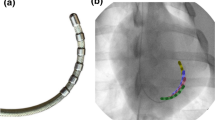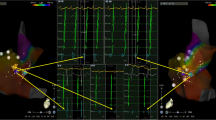Abstract
Background: Double potential (DP) activation patterns observed in coronary sinus (CS) electrograms recorded during left lateral atrial pacing, were explained by an initial low-frequency left atrial (LA) activation potential and secondary high-frequency CS musculature activation potential in canine hearts. Moreover, the connections between the LA and CS musculature vary greatly in size and location in the human heart. The purpose of this study was to investigate the relationship between the CS activation pattern during retrograde conduction via an accessory pathway (AP) and the location of left-sided APs.
Methods and Results: Fifty-one patients (31 males, mean age 48.6 years) who underwent radiofrequency catheter ablation of left-sided APs were divided into two groups according to the successful ablation site. The CS electrograms during retrograde AP conduction were classified into 3 types; single, fractionated, and DP activation patterns. A DP pattern was identified in 10 of 12 patients (83.3%) with posteroseptal to posterolateral APs, and in particular, 9 had a divergent sequence. Twenty-six of 39 patients (66.7%) with lateral to anterolateral APs, demonstrated a single pattern. The number of radiofrequency applications was significantly higher in patients with a DP pattern than in those with a single pattern (3.4 ± 3.3 vs. 7.8 ± 6.8, p < 0.01).
Conclusion: Misleading information obtained when mapping for optimal ablation sites might result from DP patterns with a divergent sequence produced by discrete muscular connections between the LA and CS musculature. Ablation around left posterior APs may require meticulous observation of the CS activation patterns.
Similar content being viewed by others
References
Jackman WM, Wang XZ, Friday KJ, Roman CA, Moulton KP, Beckman KJ, McClelland JH, Twidale N, Hazlitt HA, Prior MI, Margolis PD, Calame JD, Overholt ED, Lazzara R. Catheter ablation of accessory pathways (Wolff-Parkinson-White syndrome) by radiofrequency current. N Engl J Med 1991;324:1605-1611.
Calkins H, Langberg J, Sousa J, el-Atassi R, Leon A, Kou W, Kalbfleisch S, Morady F. Radiofrequency catheter ablation of accessory atrioventricular connections in 250 patients. Abbreviated therapeutic approach to Wolff-Parkinson-White syndrome. Circulation 1992;85:1337-1346.
Lesh MD, Van Hare GF, Schamp DJ, Chien W, Lee MA, Griffin JC, Langberg JJ, Cohen TJ, Lurie KG, Scheinman MM. Curative percutaneous catheter ablation using radiofrequency energy for accessory pathways in all locations: Results in 100 consecutive patients. J Am Coll Cardiol 1992;19:1303-1309.
Antz M, Otomo K, Arruda M, Scherlag BJ, Pitha J, Tondo C, Lazzara R, Jackman WM. Electrical conduction between the right atrium and the left atrium via the musculature of the coronary sinus. Circulation 1998;98:1790-1795.
Chauvin M, Shah DC, Haissaguerre M, Marcellin L, Brechenmacher C. The anatomic basis of connections between the coronary sinus musculature and the left atrium in humans. Circulation 2000;101:647-652.
Sun Y, Arruda M, Otomo K, Beckman K, Nakagawa H, Calame J, Po S, Spector P, Lustgarten D, Herring L, Lazzara R, Jackman WM. Coronary sinus-ventricular accessory connections producing posteroseptal and left posterior accessory pathways. Incidence and electrophysiological identification. Circulation 2002;106:1362-1367.
Suyama K, Kurita T, Shimizu W, Matsuo K, Taguchi A, Aihara N, Kamakura S, Shimomura K. Radiofrequency catheter ablation of concealed atrioventricular accessory pathways using a "simultaneous pacing method." PACE 1998;21:1693-1699.
Kasai A, Anselme F, Saoudi N. Myocardial connections between left atrial myocardium and coronary sinus musculature in man. J Cardiovasc Electrophysiol 2001;12:981-985.
Shinbane JS, Lesh MD, Stevenson WG, Klitzner TS, Natterson PD, Wiener I, Ursell PC, Saxon LA. Anatomic and electrophysiologic relation between the coronary sinus and mitral annulus: Implications for ablation of left-sided accessory pathways. Am Heart J 1998;135:93-98.
Jackman WM, Friday KJ, Yeung-Lai-Wah JA, Fitzgerald DM, Beck B, Bowman AJ, Stelzer P, Harrison L, Lazzara R. New catheter technique for recording left free-wall accessory atrioventricular pathway activation, Identification of pathway fiber orientation. Circulation 1988;78:598-610.
Otoma K, Gonzalez MD, Beckman KJ, Nakagawa H, Becker AE, Shah N, Matsudaira K, Wang Z, Lazzara R, Jackman WM. Reversing the direction of paced ventricular and atrial wavefronts reveals an oblique course in accessory AV pathways and improves localization for catheter ablation. Circulation 2001;104:550-556.
Author information
Authors and Affiliations
Rights and permissions
About this article
Cite this article
Uchida, F., Fujii, E., Matsuoka, K. et al. Effect of Left Atrial-Coronary Sinus Musculature Connections on the Coronary Sinus Activation Pattern via Retrograde Conduction in Patients with WPW Syndrome. J Interv Card Electrophysiol 10, 59–64 (2004). https://doi.org/10.1023/B:JICE.0000011486.06234.50
Issue Date:
DOI: https://doi.org/10.1023/B:JICE.0000011486.06234.50




